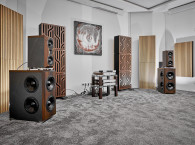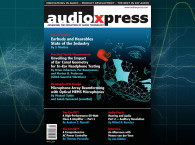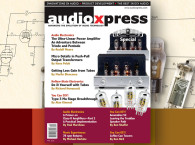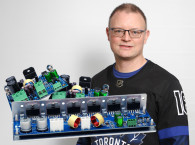 Every May, we publish the Glass Audio/Tube Focus edition of audioXpress. For the 2024 issue, audioXpress is proud to present two high-quality practical projects, together with two in-depth explorations of tube electronics, all written by leading experts in this field.
Every May, we publish the Glass Audio/Tube Focus edition of audioXpress. For the 2024 issue, audioXpress is proud to present two high-quality practical projects, together with two in-depth explorations of tube electronics, all written by leading experts in this field.The first DIY article details the theory and construction of the TubeSociety TS-2022-OTL amplifier, another unique project conceived by Menno van der Veen’s TubeSociety. Every year, TubeSociety designs and builds a new type of tube amplifier, and for this project they decided to explore an output-transformer-less (OTL) hybrid design: a non-feedback hybrid amplifier with a Tube driver and push-pull MOSFET output stage. As Menno van der Veen described the result, “Without any global negative feedback, this amp shows the beautiful tube-amp spacious sound character and mild overdrive where we were aiming at, plus a lot of power.”
The second article in the DIY perspective, written by Tim Mellow and Peter Farrow, is a Low-Feedback Triode Amplifier with Zero Output Impedance (ZOI). This is a very high-quality project that resulted from the collaboration between the two authors, now working together on a new venture called English Acoustics. Mellow previously designed an OTL amplifier with inherent load protection and symmetry throughout, which was published in audioXpress in February 2010. He is designing circuits and audio transformers for English Acoustics, which Farrow started in 2016. Farrow has designed many tube amplifiers in multiple topologies, always praised for their sound and build quality.

Divided in two parts, this issue introduces the Zero Output Impedance amplifier concept, and discusses the design for a single-ended input version. In Part 2 (June 2024), the concept is extended to a balanced input version, with performance measurements. There will be two Appendices that provide detailed design calculations for both configurations.
Evolving from a practical to a theoretical approach, the next article is written by Rudolf Moers, discussing Tube Output Power, or more precisely, determining output transformer impedance for maximum output power. Motivated by one of the pervasive myths in single-ended audio tube amplifier design, that the maximum output efficiency that can be obtained is 25%, Moers compares several methods to determine the output transformer impedance for a triode tube amplifier output stage to obtain maximum output power. The methods give different results that can be questioned, nevertheless showing that efficiencies greater than 25% are possible.
A second article in the broader audio electronics domain, brought by Christopher Paul, explores the possibility of extending the features of the venerable SRPP circuit, and specifically some concepts involving matched and unmatched triodes. In Optimizing Single-Stage Dual-Triode Totem Pole Drivers, Paul states that what makes these dual-triode circuits interesting is the ability to combine some of the low impedance output characteristics of a cathode follower with the voltage amplification capability of a common-cathode stage, all while sharing the load driving responsibilities equally between the two triodes. But that’s just the start of the exploration.

This issue also features a new contribution by Dimitri Danyuk, which many of our readers recognized from previous very high-level contributions. In a previous article for audioXpress, Danyuk discussed open-loop complementary current followers, which have generated great interest and numerous requests for additional information. For this add-on article, the Open-Loop Complementary Follower as an Amplifying Stage, Danyuk delves deeper into transconductance stage implementation, and other considerations.
Although there’s more in the audio electronics domain in this issue, we step away from tubes to enter the always fascinating world of acoustics. In his Sound Control column, Richard Honeycutt writes about acoustical absorption and how new 21st century materials enable balanced sound absorption while meeting an increasingly important requirement: sustainability. Meeting those two goals effectively deserves some explorations with real examples, which is what this article details.
And from acoustics, we go straight to another fascinating project that combines all disciplines that make great sound. Rens Tellers and Jan Didden traveled to Germany to learn about the Pure Acourate Sound Project, which aims to create the lowest distortion sound in a listening room. The initiators of the Pure Acourate Sound project are Ulrich Brüggemann, Markus Grelka, and Ralf Höllmann. The partners involved in this unique system are Purifi Audio, Okto Research, GIK Acoustics, Klippel, Roon, AudioVero, Rose Handwerk, and Joachim Gerhard. Ahead of the presentation at the May 2024 Munich High-End show, audioXpress offers a preview of the project.
Next, Tom Christiansen offers his very own account of his professional journey that led to the creation of his company, successfully serving audio enthusiasts all over the world with a complete range of power amplifiers kits and circuits, ranging from 40W to 240W (8Ω) - all well-engineered, thoroughly tested, and well-documented. In The Neurochrome Story, Christiansen shares what it is like to build a small, highly dedicated audio company, providing inspiration, or perhaps a forewarning, for those wishing to venture into the audio business.
And finally, there’s even more practical builds, with the second part of A High-Performance 60-Watt Class A Amplifier, by Andrew C. Russell. This project, named the ax-Amplifier, uses Augmented Feedback Error Correction (AFEC) to achieve ultra-low distortion and improve key audio performance parameters without adding too much complexity and cost. The first part of this article described the amplifier design in detail, with this second and final part detailing the power supply system and conclusion with measurements. We know many of our readers would like to build a high-quality amplifier, and this project, designed by the founder of Hifisonix.com, delivers on every front.

All the content contained in every issue of audioXpress is the reason, month after month, 12 times per year, this publication continues to reinforce its role as an essential resource for the audio industry. Your support and that of our advertisers is what allows us to keep this publication in print and all digital platforms and pay our independent authors and contributors for their work.
Subscribe if you haven't done so yet in order not to miss future issues or renew your subscription. Subscribing to the digital online version allows immediate access and is available here: audioXpress Subscription Services
If you wish to buy a single printed issue or the complete audioXpress archive on USB, from 2000 to 2024 (yes, including the latest issue), just visit our online shop at www.cc-webshop.com
Don't miss out, get your copy of audioXpress right now at www.gotomyxpress.com






